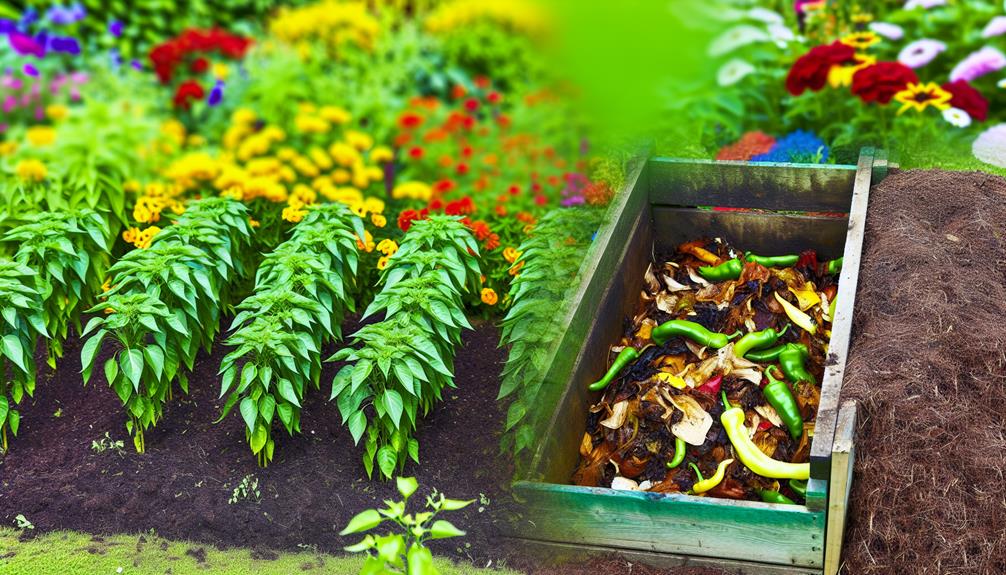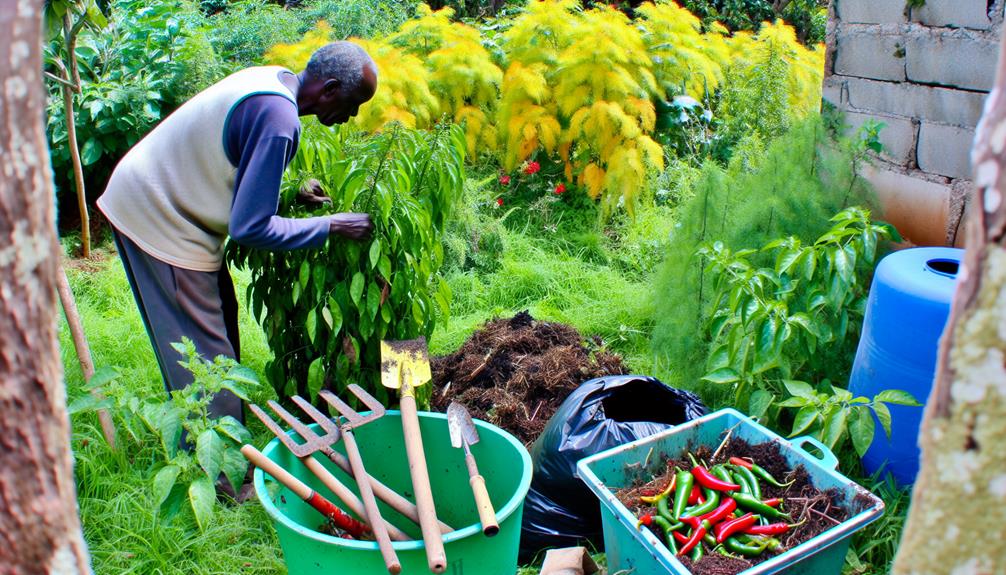

You can compost pepper plants effectively by following a few key steps. Begin by chopping the stalks into smaller pieces to speed up decomposition. Make sure fruits are disease and pest-free before adding them to the compost. Balance your compost with both green (nitrogen-rich) materials like pepper plants and brown (carbon-rich) materials like shredded newspaper.
Regularly turn the compost pile to introduce oxygen and keep it moist but not waterlogged. Avoid common mistakes, such as adding meat or diseased plants. Doing so helps create nutrient-rich compost for your garden. There are also other ways to recycle your pepper plants.
Composting pepper plants enriches the soil with essential nutrients, boosting garden fertility. When you compost pepper plants, you engage in nutrient recycling, which means returning valuable minerals and organic matter back into the soil. This process contributes greatly to soil enrichment, making your garden more productive and sustainable.
You might wonder what makes composting pepper plants so beneficial. Firstly, the organic matter from the plants breaks down and becomes humus, a rich component of healthy soil. This humus improves soil structure, allowing it to retain moisture and nutrients more effectively. Additionally, composted pepper plants add key nutrients like nitrogen, potassium, and phosphorus back into the soil, which are vital for plant growth.
To make sure you’re getting the most out of your composting efforts, consider maintaining a balanced compost pile. Mix the pepper plants with other compost materials like kitchen scraps, leaves, and grass clippings. Turn the pile regularly to aerate it, which helps speed up the decomposition process. By doing so, you’ll create a thriving garden ecosystem where plants can flourish, and you’ll be part of a community of gardeners dedicated to sustainable practices.
Understanding the various types of pepper plant waste can help you make the most of your composting efforts. Composting pepper plants involves managing the plant stalks and discarded fruits effectively.
Plant stalks are a significant component of pepper plant waste. These stalks are rich in carbon, making them a valuable addition to your compost pile. When you chop them into smaller pieces, they break down more quickly, aiding the composting process. Additionally, the fibrous nature of plant stalks helps improve the structure of your compost, promoting better aeration and faster decomposition.
Discarded fruits, another common type of pepper plant waste, are rich in nitrogen. They balance the carbon content from the plant stalks, creating an ideal environment for decomposition. Be sure that the discarded fruits are free from any diseases or pests before adding them to your compost. This precaution helps maintain a healthy compost pile and prevents potential issues.
Incorporating both plant stalks and discarded fruits into your compost ensures a well-balanced mix of carbon and nitrogen. This mixture accelerates the composting process and produces nutrient-rich compost for your garden.
Also Read: Can You Compost Cardboard Tubes?
To prepare pepper plants for compost, start by immersing yourself in chopping the plant stalks into smaller pieces. This step helps accelerate the decomposition process and guarantees even breakdown in your compost bin.

Before you engage in cutting, gather your cleaning tools. Clean pruners or garden shears will prevent the spread of disease and make the chopping easier.
Once you’ve got the pepper plant parts chopped, think about your soil preparation. Proper soil preparation involves balancing green and brown materials to create a nutrient-rich compost. Pepper plants are considered green material, which is high in nitrogen and essential for a healthy compost. Mixing these chopped pepper plant pieces with brown materials like dried leaves or newspaper will create the right balance needed for effective composting.
Next, make certain that your compost pile has adequate moisture. Pepper plants, like all green materials, contain water, but adding extra moisture can help. Turn the compost regularly to aerate and expedite decomposition.
While preparing your pepper plants for compost is important, it’s equally essential to be aware of common composting mistakes that can hinder your efforts. One significant mistake is adding meat to your compost pile. Meat products attract pests and can slow down the decomposition process. Instead, stick to plant-based materials that decompose more efficiently and keep pests at bay.
Another frequent issue is plastic contamination. Make sure that all plastic materials are removed from your compostable waste. Even small plastic pieces can disrupt the composting process and contaminate your final product. Always double-check for any plastic before adding items to your compost pile.
Below is a table summarizing these common mistakes and their impacts:
| Mistake | Impact |
|---|---|
| Adding meat | Attracts pests, slows decomposition |
| Plastic contamination | Disrupts process, contaminates compost |
| Lack of aeration | Causes odor, slows decomposition |
| Incorrect moisture | Too wet or too dry, hinders microbial activity |
Additionally, lack of aeration and incorrect moisture levels are common pitfalls. Regularly turning your compost ensures proper aeration and promotes faster decomposition. Monitor moisture levels to keep your compost pile damp but not waterlogged. By avoiding these mistakes, you’ll create high-quality compost for your pepper plants and other garden needs.
Also Read: Can You Compost Cactus?
When composting pepper plants, you might encounter a few issues, but there are straightforward solutions to keep your composting process on track. One common problem is disease management. Diseased pepper plants can introduce pathogens into your compost pile, potentially spreading to other plants.
To avoid this, avoid adding any pepper plants showing signs of disease. If you suspect a plant is diseased, it’s better to dispose of it through other means, such as burning or sending it to a municipal composting facility that reaches higher temperatures.
Pest control is another consideration. Pepper plants can attract pests like aphids or spider mites. These pests can survive the composting process and infest your garden later. To prevent this, inspect pepper plants for pests before adding them to your compost. If you find any, treat the plants with an organic insecticidal soap and remove any heavily infested parts.
Additionally, chop up the pepper plants into smaller pieces to speed up decomposition and reduce the likelihood of pests surviving.
To make sure your compost pile thrives, you need to focus on the green to brown ratio and maintaining proper moisture and aeration. Aim for a balanced mix of green materials like pepper plant scraps and brown materials like dried leaves.
Keep the pile moist but not soggy, and turn it regularly to provide adequate oxygen.
Achieving the right green to brown ratio is essential for creating a balanced and effective compost pile. Greens provide nitrogen, which fuels compost temperature and microbial activity, while browns offer carbon, giving microbes the energy they need to break down materials.
To maintain a thriving compost pile, aim for a ratio of about 2 parts greens to 1 part browns. Too many greens can cause your pile to become smelly and overly wet, while too many browns can slow down decomposition. Here’s a handy table to guide your composting efforts:
| Green Materials (Nitrogen) | Brown Materials (Carbon) |
|---|---|
| Fresh grass clippings | Dry leaves |
| Vegetable scraps | Straw or hay |
| Coffee grounds | Shredded paper/cardboard |
| Pepper plant remains | Sawdust |
Maintaining the proper moisture and aeration balance is essential for a healthy and efficient compost pile. When composting pepper plants, you need to manage both moisture retention and airflow.
Start by ensuring your compost pile is damp, like a wrung-out sponge. This moisture level helps microorganisms break down organic matter effectively.
To retain moisture, add materials like shredded newspaper or cardboard. These ‘browns‘ absorb excess water and prevent the pile from becoming too wet. On the other hand, if your compost pile feels dry, you can add ‘greens‘ like fresh pepper plant trimmings, which release water as they decompose.
Aeration is equally important. Use composting techniques like turning the pile regularly to introduce oxygen. This prevents anaerobic conditions that can lead to unpleasant smells and slow decomposition.
You can also layer materials to create air pockets, promoting better airflow.
Also Read: Can You Compost Butter?
Instead of composting pepper plants, you can repurpose them in several creative and practical ways.

One effective method is using them as mulch. By chopping up the pepper plants and spreading them around your garden, you can help retain moisture in the soil and suppress weeds. This mulching option is a simple way to recycle the plants directly back into your garden, providing nutrients as they decompose.
Another recycling method involves creating a natural fertilizer. You can dry the pepper plants and grind them into a fine powder. This powder can be sprinkled around your garden beds, offering a slow-release source of nutrients. It’s a straightforward way to enhance soil health without resorting to commercial fertilizers.
If you’re into DIY projects, consider using the stems and larger branches for crafting. They can be transformed into garden markers or small trellises for climbing plants. This not only recycles the plant material but also adds a personal touch to your garden.
Lastly, if you have a worm bin, you can feed the pepper plants to your worms. They’ll break down the plant material, turning it into nutrient-rich worm castings that are fantastic for your garden.
You shouldn’t compost pepper plants with diseases. Disease identification is essential to prevent spreading pathogens. Focus on compost sanitation by removing infected plants to keep your compost healthy and your gardening community thriving.
You should remove seeds before composting pepper plants. Seed viability can lead to unwanted germination risks in your compost. By eliminating seeds, you guarantee a cleaner, more controlled composting process that everyone in the community will appreciate.
When considering the decomposition time for pepper plants in your compost, you can expect about 2-3 months for complete organic breakdown. By composting together, you’re contributing to a healthier, more sustainable community garden.
When composting pepper plants, you might attract pepper pests, increasing composting risks. However, by maintaining a balanced compost pile, you can minimize these issues and create a richer, pest-free compost that benefits your community garden.
Composting pepper plants treated with pesticides can be risky. Pesticide residue might linger, causing soil contamination. Always verify the pesticide’s instructions to guarantee it’s safe for composting and won’t harm your garden community.
To effectively compost pepper plants, make sure you chop them into smaller pieces and mix them well with other green and brown materials. Avoid common mistakes like adding too many woody stems or diseased plants. Balance nitrogen-rich greens with carbon-rich browns for an ideal compost mix.
If composting isn’t feasible, consider alternatives like mulching or green waste disposal. Follow these steps, and you’ll enrich your soil while reducing waste efficiently.
